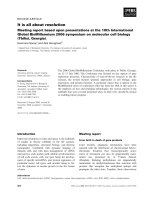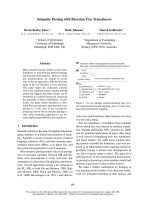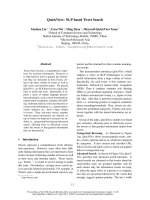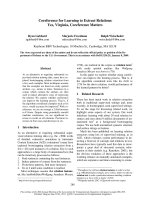Tài liệu Báo cáo khoa học: "Coreference Resolution with Reconcile" pdf
Bạn đang xem bản rút gọn của tài liệu. Xem và tải ngay bản đầy đủ của tài liệu tại đây (179.07 KB, 6 trang )
Proceedings of the ACL 2010 Conference Short Papers, pages 156–161,
Uppsala, Sweden, 11-16 July 2010.
c
2010 Association for Computational Linguistics
Coreference Resolution with Reconcile
Veselin Stoyanov
Center for Language
and Speech Processing
Johns Hopkins Univ.
Baltimore, MD
Claire Cardie
Department of
Computer Science
Cornell University
Ithaca, NY
Nathan Gilbert
Ellen Riloff
School of Computing
University of Utah
Salt Lake City, UT
David Buttler
David Hysom
Lawrence Livermore
National Laboratory
Livermore, CA
Abstract
Despite the existence of several noun phrase coref-
erence resolution data sets as well as several for-
mal evaluations on the task, it remains frustratingly
difficult to compare results across different corefer-
ence resolution systems. This is due to the high cost
of implementing a complete end-to-end coreference
resolution system, which often forces researchers
to substitute available gold-standard information in
lieu of implementing a module that would compute
that information. Unfortunately, this leads to incon-
sistent and often unrealistic evaluation scenarios.
With the aim to facilitate consistent and realis-
tic experimental evaluations in coreference resolu-
tion, we present Reconcile, an infrastructure for the
development of learning-based noun phrase (NP)
coreference resolution systems. Reconcile is de-
signed to facilitate the rapid creation of corefer-
ence resolution systems, easy implementation of
new feature sets and approaches to coreference res-
olution, and empirical evaluation of coreference re-
solvers across a variety of benchmark data sets and
standard scoring metrics. We describe Reconcile
and present experimental results showing that Rec-
oncile can be used to create a coreference resolver
that achieves performance comparable to state-of-
the-art systems on six benchmark data sets.
1 Introduction
Noun phrase coreference resolution (or simply
coreference resolution) is the problem of identi-
fying all noun phrases (NPs) that refer to the same
entity in a text. The problem of coreference res-
olution is fundamental in the field of natural lan-
guage processing (NLP) because of its usefulness
for other NLP tasks, as well as the theoretical in-
terest in understanding the computational mech-
anisms involved in government, binding and lin-
guistic reference.
Several formal evaluations have been conducted
for the coreference resolution task (e.g., MUC-6
(1995), ACE NIST (2004)), and the data sets cre-
ated for these evaluations have become standard
benchmarks in the field (e.g., MUC and ACE data
sets). However, it is still frustratingly difficult to
compare results across different coreference res-
olution systems. Reported coreference resolu-
tion scores vary wildly across data sets, evaluation
metrics, and system configurations.
We believe that one root cause of these dispar-
ities is the high cost of implementing an end-to-
end coreference resolution system. Coreference
resolution is a complex problem, and successful
systems must tackle a variety of non-trivial sub-
problems that are central to the coreference task —
e.g., mention/markable detection, anaphor identi-
fication — and that require substantial implemen-
tation efforts. As a result, many researchers ex-
ploit gold-standard annotations, when available, as
a substitute for component technologies to solve
these subproblems. For example, many published
research results use gold standard annotations to
identify NPs (substituting for mention/markable
detection), to distinguish anaphoric NPs from non-
anaphoric NPs (substituting for anaphoricity de-
termination), to identify named entities (substitut-
ing for named entity recognition), and to identify
the semantic types of NPs (substituting for seman-
tic class identification). Unfortunately, the use of
gold standard annotations for key/critical compo-
nent technologies leads to an unrealistic evalua-
tion setting, and makes it impossible to directly
compare results against coreference resolvers that
solve all of these subproblems from scratch.
Comparison of coreference resolvers is further
hindered by the use of several competing (and
non-trivial) evaluation measures, and data sets that
have substantially different task definitions and
annotation formats. Additionally, coreference res-
olution is a pervasive problem in NLP and many
NLP applications could benefit from an effective
coreference resolver that can be easily configured
and customized.
To address these issues, we have created a plat-
form for coreference resolution, called Reconcile,
that can serve as a software infrastructure to sup-
port the creation of, experimentation with, and
evaluation of coreference resolvers. Reconcile
was designed with the following seven desiderata
in mind:
• implement the basic underlying software ar-
156
chitecture of contemporary state-of-the-art
learning-based coreference resolution sys-
tems;
• support experimentation on most of the stan-
dard coreference resolution data sets;
• implement most popular coreference resolu-
tion scoring metrics;
• exhibit state-of-the-art coreference resolution
performance (i.e., it can be configured to cre-
ate a resolver that achieves performance close
to the best reported results);
• can be easily extended with new methods and
features;
• is relatively fast and easy to configure and
run;
• has a set of pre-built resolvers that can be
used as black-box coreference resolution sys-
tems.
While several other coreference resolution sys-
tems are publicly available (e.g., Poesio and
Kabadjov (2004), Qiu et al. (2004) and Versley et
al. (2008)), none meets all seven of these desider-
ata (see Related Work). Reconcile is a modular
software platform that abstracts the basic archi-
tecture of most contemporary supervised learning-
based coreference resolution systems (e.g., Soon
et al. (2001), Ng and Cardie (2002), Bengtson and
Roth (2008)) and achieves performance compara-
ble to the state-of-the-art on several benchmark
data sets. Additionally, Reconcile can be eas-
ily reconfigured to use different algorithms, fea-
tures, preprocessing elements, evaluation settings
and metrics.
In the rest of this paper, we review related work
(Section 2), describe Reconcile’s organization and
components (Section 3) and show experimental re-
sults for Reconcile on six data sets and two evalu-
ation metrics (Section 4).
2 Related Work
Several coreference resolution systems are cur-
rently publicly available. JavaRap (Qiu et al.,
2004) is an implementation of the Lappin and
Leass’ (1994) Resolution of Anaphora Procedure
(RAP). JavaRap resolves only pronouns and, thus,
it is not directly comparable to Reconcile. GuiTaR
(Poesio and Kabadjov, 2004) and BART (Versley
et al., 2008) (which can be considered a succes-
sor of GuiTaR) are both modular systems that tar-
get the full coreference resolution task. As such,
both systems come close to meeting the majority
of the desiderata set forth in Section 1. BART,
in particular, can be considered an alternative to
Reconcile, although we believe that Reconcile’s
approach is more flexible than BART’s. In addi-
tion, the architecture and system components of
Reconcile (including a comprehensive set of fea-
tures that draw on the expertise of state-of-the-art
supervised learning approaches, such as Bengtson
and Roth (2008)) result in performance closer to
the state-of-the-art.
Coreference resolution has received much re-
search attention, resulting in an array of ap-
proaches, algorithms and features. Reconcile
is modeled after typical supervised learning ap-
proaches to coreference resolution (e.g. the archi-
tecture introduced by Soon et al. (2001)) because
of the popularity and relatively good performance
of these systems.
However, there have been other approaches
to coreference resolution, including unsupervised
and semi-supervised approaches (e.g. Haghighi
and Klein (2007)), structured approaches (e.g.
McCallum and Wellner (2004) and Finley and
Joachims (2005)), competition approaches (e.g.
Yang et al. (2003)) and a bell-tree search approach
(Luo et al. (2004)). Most of these approaches rely
on some notion of pairwise feature-based similar-
ity and can be directly implemented in Reconcile.
3 System Description
Reconcile was designed to be a research testbed
capable of implementing most current approaches
to coreference resolution. Reconcile is written in
Java, to be portable across platforms, and was de-
signed to be easily reconfigurable with respect to
subcomponents, feature sets, parameter settings,
etc.
Reconcile’s architecture is illustrated in Figure
1. For simplicity, Figure 1 shows Reconcile’s op-
eration during the classification phase (i.e., assum-
ing that a trained classifier is present).
The basic architecture of the system includes
five major steps. Starting with a corpus of docu-
ments together with a manually annotated corefer-
ence resolution answer key
1
, Reconcile performs
1
Only required during training.
157
Figure 1: The Reconcile classification architecture.
the following steps, in order:
1. Preprocessing. All documents are passed
through a series of (external) linguistic pro-
cessors such as tokenizers, part-of-speech
taggers, syntactic parsers, etc. These com-
ponents produce annotations of the text. Ta-
ble 1 lists the preprocessors currently inter-
faced in Reconcile. Note that Reconcile in-
cludes several in-house NP detectors, that
conform to the different data sets’ defini-
tions of what constitutes a NP (e.g., MUC
vs. ACE). All of the extractors utilize a syn-
tactic parse of the text and the output of a
Named Entity (NE) extractor, but extract dif-
ferent constructs as specialized in the corre-
sponding definition. The NP extractors suc-
cessfully recognize about 95% of the NPs in
the MUC and ACE gold standards.
2. Feature generation. Using annotations pro-
duced during preprocessing, Reconcile pro-
duces feature vectors for pairs of NPs. For
example, a feature might denote whether the
two NPs agree in number, or whether they
have any words in common. Reconcile in-
cludes over 80 features, inspired by other suc-
cessful coreference resolution systems such
as Soon et al. (2001) and Ng and Cardie
(2002).
3. Classification. Reconcile learns a classifier
that operates on feature vectors representing
Task Systems
Sentence UIUC (CC Group, 2009)
splitter OpenNLP (Baldridge, J., 2005)
Tokenizer OpenNLP (Baldridge, J., 2005)
POS OpenNLP (Baldridge, J., 2005)
Tagger + the two parsers below
Parser Stanford (Klein and Manning, 2003)
Berkeley (Petrov and Klein, 2007)
Dep. parser Stanford (Klein and Manning, 2003)
NE OpenNLP (Baldridge, J., 2005)
Recognizer Stanford (Finkel et al., 2005)
NP Detector In-house
Table 1: Preprocessing components available in
Reconcile.
pairs of NPs and it is trained to assign a score
indicating the likelihood that the NPs in the
pair are coreferent.
4. Clustering. A clustering algorithm consoli-
dates the predictions output by the classifier
and forms the final set of coreference clusters
(chains).
2
5. Scoring. Finally, during testing Reconcile
runs scoring algorithms that compare the
chains produced by the system to the gold-
standard chains in the answer key.
Each of the five steps above can invoke differ-
ent components. Reconcile’s modularity makes it
2
Some structured coreference resolution algorithms (e.g.,
McCallum and Wellner (2004) and Finley and Joachims
(2005)) combine the classification and clustering steps above.
Reconcile can easily accommodate this modification.
158
Step Available modules
Classification various learners in the Weka toolkit
libSVM (Chang and Lin, 2001)
SVM
light
(Joachims, 2002)
Clustering Single-link
Best-First
Most Recent First
Scoring MUC score (Vilain et al., 1995)
B
3
score (Bagga and Baldwin, 1998)
CEAF score (Luo, 2005)
Table 2: Available implementations for different
modules available in Reconcile.
easy for new components to be implemented and
existing ones to be removed or replaced. Recon-
cile’s standard distribution comes with a compre-
hensive set of implemented components – those
available for steps 2–5 are shown in Table 2. Rec-
oncile contains over 38,000 lines of original Java
code. Only about 15% of the code is concerned
with running existing components in the prepro-
cessing step, while the rest deals with NP extrac-
tion, implementations of features, clustering algo-
rithms and scorers. More details about Recon-
cile’s architecture and available components and
features can be found in Stoyanov et al. (2010).
4 Evaluation
4.1 Data Sets
Reconcile incorporates the six most commonly
used coreference resolution data sets, two from the
MUC conferences (MUC-6, 1995; MUC-7, 1997)
and four from the ACE Program (NIST, 2004).
For ACE, we incorporate only the newswire por-
tion. When available, Reconcile employs the stan-
dard test/train split. Otherwise, we randomly split
the data into a training and test set following a
70/30 ratio. Performance is evaluated according
to the B
3
and MUC scoring metrics.
4.2 The Reconcile
2010
Configuration
Reconcile can be easily configured with differ-
ent algorithms for markable detection, anaphoric-
ity determination, feature extraction, etc., and run
against several scoring metrics. For the purpose of
this sample evaluation, we create only one partic-
ular instantiation of Reconcile, which we will call
Reconcile
2010
to differentiate it from the general
platform. Reconcile
2010
is configured using the
following components:
1. Preprocessing
(a) Sentence Splitter: OpenNLP
(b) Tokenizer: OpenNLP
(c) POS Tagger: OpenNLP
(d) Parser: Berkeley
(e) Named Entity Recognizer: Stanford
2. Feature Set - A hand-selected subset of 60 out of the
more than 80 features available. The features were se-
lected to include most of the features from Soon et al.
Soon et al. (2001), Ng and Cardie (2002) and Bengtson
and Roth (2008).
3. Classifier - Averaged Perceptron
4. Clustering - Single-link - Positive decision threshold
was tuned by cross validation of the training set.
4.3 Experimental Results
The first two rows of Table 3 show the perfor-
mance of Reconcile
2010
. For all data sets, B
3
scores are higher than MUC scores. The MUC
score is highest for the MUC6 data set, while B
3
scores are higher for the ACE data sets as com-
pared to the MUC data sets.
Due to the difficulties outlined in Section 1,
results for Reconcile presented here are directly
comparable only to a limited number of scores
reported in the literature. The bottom three
rows of Table 3 list these comparable scores,
which show that Reconcile
2010
exhibits state-of-
the-art performance for supervised learning-based
coreference resolvers. A more detailed study of
Reconcile-based coreference resolution systems
in different evaluation scenarios can be found in
Stoyanov et al. (2009).
5 Conclusions
Reconcile is a general architecture for coreference
resolution that can be used to easily create various
coreference resolvers. Reconcile provides broad
support for experimentation in coreference reso-
lution, including implementation of the basic ar-
chitecture of contemporary state-of-the-art coref-
erence systems and a variety of individual mod-
ules employed in these systems. Additionally,
Reconcile handles all of the formatting and scor-
ing peculiarities of the most widely used coref-
erence resolution data sets (those created as part
of the MUC and ACE conferences) and, thus,
allows for easy implementation and evaluation
across these data sets. We hope that Reconcile
will support experimental research in coreference
resolution and provide a state-of-the-art corefer-
ence resolver for both researchers and application
developers. We believe that in this way Recon-
cile will facilitate meaningful and consistent com-
parisons of coreference resolution systems. The
full Reconcile release is available for download at
/>159
System Score Data sets
MUC6 MUC7 ACE-2 ACE03 ACE04 ACE05
Reconcile
2010
M U C 68.50 62.80 65.99 67.87 62.03 67.41
B
3
70.88 65.86 78.29 79.39 76.50 73.71
Soon et al. (2001) M U C 62.6 60.4 – – – –
Ng and Cardie (2002) M U C 70.4 63.4 – – – –
Yang et al. (2003) M U C 71.3 60.2 – – – –
Table 3: Scores for Reconcile on six data sets and scores for comparable coreference systems.
Acknowledgments
This research was supported in part by the Na-
tional Science Foundation under Grant # 0937060
to the Computing Research Association for the
CIFellows Project, Lawrence Livermore National
Laboratory subcontract B573245, Department of
Homeland Security Grant N0014-07-1-0152, and
Air Force Contract FA8750-09-C-0172 under the
DARPA Machine Reading Program.
The authors would like to thank the anonymous
reviewers for their useful comments.
References
A. Bagga and B. Baldwin. 1998. Algorithms for scoring
coreference chains. In Linguistic Coreference Workshop
at the Language Resources and Evaluation Conference.
Baldridge, J. 2005. The OpenNLP project.
/>E. Bengtson and D. Roth. 2008. Understanding the value of
features for coreference resolution. In Proceedings of the
2008 Conference on Empirical Methods in Natural Lan-
guage Processing (EMNLP).
CC Group. 2009. Sentence Segmentation Tool.
cogcomp/atool.php?tkey=SS.
C. Chang and C. Lin. 2001. LIBSVM: a Li-
brary for Support Vector Machines. Available at
/>J. Finkel, T. Grenager, and C. Manning. 2005. Incorporating
Non-local Information into Information Extraction Sys-
tems by Gibbs Sampling. In Proceedings of the 21st In-
ternational Conference on Computational Linguistics and
44th Annual Meeting of the ACL.
T. Finley and T. Joachims. 2005. Supervised clustering with
support vector machines. In Proceedings of the Twenty-
second International Conference on Machine Learning
(ICML 2005).
A. Haghighi and D. Klein. 2007. Unsupervised Coreference
Resolution in a Nonparametric Bayesian Model. In Pro-
ceedings of the 45th Annual Meeting of the ACL.
T. Joachims. 2002. SVM
Light
, .
D. Klein and C. Manning. 2003. Fast Exact Inference with
a Factored Model for Natural Language Parsing. In Ad-
vances in Neural Information Processing (NIPS 2003).
S. Lappin and H. Leass. 1994. An algorithm for pronom-
inal anaphora resolution. Computational Linguistics,
20(4):535–561.
X. Luo, A. Ittycheriah, H. Jing, N. Kambhatla, and
S. Roukos. 2004. A mention-synchronous coreference
resolution algorithm based on the bell tree. In Proceed-
ings of the 42nd Annual Meeting of the ACL.
X. Luo. 2005. On Coreference Resolution Performance
Metrics. In Proceedings of Human Language Technology
Conference and Conference on Empirical Methods in Nat-
ural Language Processing (HLT/EMNLP).
A. McCallum and B. Wellner. 2004. Conditional Models
of Identity Uncertainty with Application to Noun Coref-
erence. In Advances in Neural Information Processing
(NIPS 2004).
MUC-6. 1995. Coreference Task Definition. In Proceedings
of the Sixth Message Understanding Conference (MUC-
6).
MUC-7. 1997. Coreference Task Definition. In Proceed-
ings of the Seventh Message Understanding Conference
(MUC-7).
V. Ng and C. Cardie. 2002. Improving Machine Learning
Approaches to Coreference Resolution. In Proceedings of
the 40th Annual Meeting of the ACL.
NIST. 2004. The ACE Evaluation Plan. NIST.
S. Petrov and D. Klein. 2007. Improved Inference for Un-
lexicalized Parsing. In Proceedings of the Joint Meeting
of the Human Language Technology Conference and the
North American Chapter of the Association for Computa-
tional Linguistics (HLT-NAACL 2007).
M. Poesio and M. Kabadjov. 2004. A general-purpose,
off-the-shelf anaphora resolution module: implementation
and preliminary evaluation. In Proceedings of the Lan-
guage Resources and Evaluation Conference.
L. Qiu, M Y. Kan, and T S. Chua. 2004. A public reference
implementation of the rap anaphora resolution algorithm.
In Proceedings of the Language Resources and Evaluation
Conference.
W. Soon, H. Ng, and D. Lim. 2001. A Machine Learning Ap-
proach to Coreference of Noun Phrases. Computational
Linguistics, 27(4):521–541.
V. Stoyanov, N. Gilbert, C. Cardie, and E. Riloff. 2009. Co-
nundrums in noun phrase coreference resolution: Mak-
ing sense of the state-of-the-art. In Proceedings of
ACL/IJCNLP.
160
V. Stoyanov, C. Cardie, N. Gilbert, E. Riloff, D. Buttler, and
D. Hysom. 2010. Reconcile: A coreference resolution
research platform. Technical report, Cornell University.
Y. Versley, S. Ponzetto, M. Poesio, V. Eidelman, A. Jern,
J. Smith, X. Yang, and A. Moschitti. 2008. BART: A
modular toolkit for coreference resolution. In Proceed-
ings of the Language Resources and Evaluation Confer-
ence.
M. Vilain, J. Burger, J. Aberdeen, D. Connolly, and
L. Hirschman. 1995. A Model-Theoretic Coreference
Scoring Theme. In Proceedings of the Sixth Message Un-
derstanding Conference (MUC-6).
X. Yang, G. Zhou, J. Su, and C. Tan. 2003. Coreference
resolution using competition learning approach. In Pro-
ceedings of the 41st Annual Meeting of the ACL.
161









